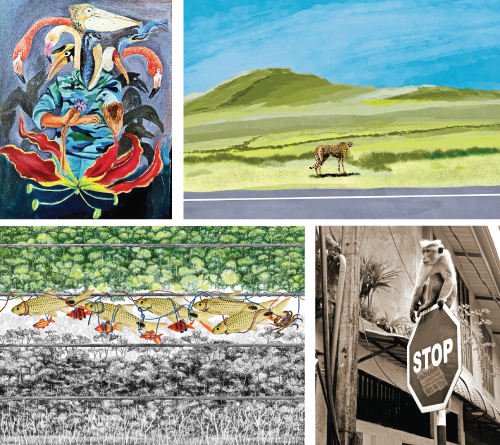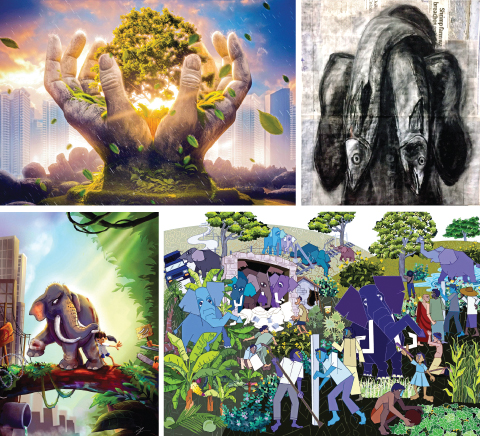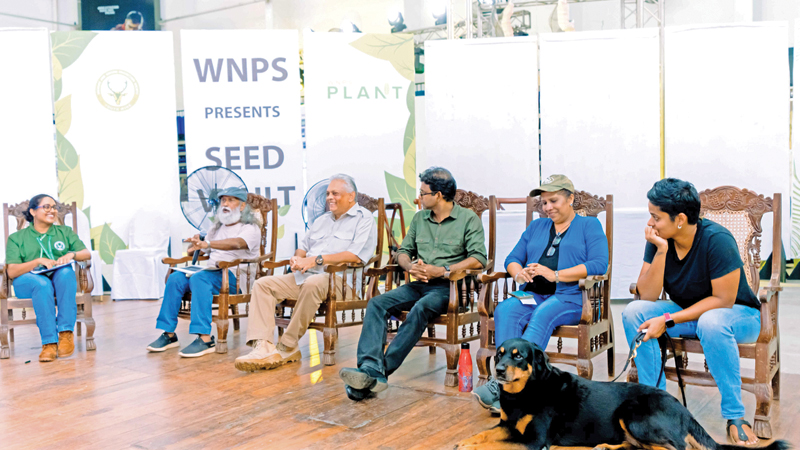The Youth Wing of the Wildlife and Nature Protection Society of Sri Lanka (WNPS), in association with USAID, opened the “Tales of Conservation” exhibiion that uses art to inspire envronmental awareness and action. This activity-centered exhibition cast a wide net to incorporate various artworks on waste management, conservation, climate change, education, and environmental legislation—all of which intersect with the irreplaceable human need for maintaining the natural environment.
 Sri Lanka is one of the biodiversity hotspots of the world, and the island has a wide diversity of ecosystems—from rainforest to the untouched marine floors. All these unique ecological diversities are at a constant threat of being hampered by destructive factors such as habitat destruction due to human activities, unreasonable practices, pollution, and the flow of humans into the natural environment, thus leading to man-animal conflict. Exhibition artists -Nirusha Nadarajah, R. Dilochchini, Kaushalya Suwandahennadi, Jayaweera Kankanamge Nimsis Hansani, and Jayath de Silva would use their creativity to symbolise and highlight such threats to underscore the urgency at which it is necessary to save Sri Lanka’s valuable biodiversity. Through their powerful artwork, they called on individuals and communities to embrace sustainable practices and support conservation efforts.
Sri Lanka is one of the biodiversity hotspots of the world, and the island has a wide diversity of ecosystems—from rainforest to the untouched marine floors. All these unique ecological diversities are at a constant threat of being hampered by destructive factors such as habitat destruction due to human activities, unreasonable practices, pollution, and the flow of humans into the natural environment, thus leading to man-animal conflict. Exhibition artists -Nirusha Nadarajah, R. Dilochchini, Kaushalya Suwandahennadi, Jayaweera Kankanamge Nimsis Hansani, and Jayath de Silva would use their creativity to symbolise and highlight such threats to underscore the urgency at which it is necessary to save Sri Lanka’s valuable biodiversity. Through their powerful artwork, they called on individuals and communities to embrace sustainable practices and support conservation efforts.
Nadarajah’s work celebrated the delicate beauty of Sri Lanka’s endemic birdwing butterfly, emphasising the crucial importance of butterfly conservation. By illustrating the butterfly’s life cycle, the artist encouraged viewers to create butterfly-friendly habitats in their gardens, contributing to the preservation of these vital pollinators.
Spectacular pictures
Dilochchini’s “Shadows of Extinction” poignantly illustrated the sorrows of endangered bird species. The spectacular pictures of bird silhouettes against the disappearing backdrop dramatically portrayed the annihilating impacts of habitat destruction and environmental degradation on these endangered creatures. The completion was a strong appeal to action, calling upon viewers to join in protection efforts for bird habitats.
Suwandahennadi’s digital artwork brought attention to the destructive impact of small-scale hydropower plants on sensitive ecosystems. By highlighting the plight of the critically endangered Asoka barb, the artist emphasised the environmental consequences of these projects on biodiversity. The sharp visual contrast between a vibrant forest and a desolate landscape underscored the urgent need for sustainable development practices.
The personal approach taken by Hansani’s artwork took up a human-elephant conflict in Sri Lanka and expressed very diverse feelings and challenges through semi-cubism—the technique. The work focused on community-driven solutions such as electric fences, emphasising human-wildlife coexistence and a kinder, more sustainable approach to wildlife conservation. Jayath de Silva’s works have been dedicated to the lost beauty of the Barbary Lion, which has been drawn into a very poignant parallel with the condition of the critically endangered Asiatic Cheetah.
The artist adds a solitary cheetah near extinction to stress the need for immediate conservation intervention to safeguard this magnificent species and the particular habitat in which it resides from further debilitation.
 The exhibition gained another dimension through a panel discussion that delved deeper into Sri Lanka’s conservation challenges, moderated by Pavithra Attanayake, a young conservation enthusiast. Esteemed experts included Ms. Anya Ratnayaka; Conservation biologist, Dr. Sumith Pilapitiya, Prof. Sampath Seneviratne, Prof. Sarath Kotagama and Prof. Enoka Kudavidanage in the panel. Their collective insights complemented the thought-provoking artwork, offering a comprehensive understanding of the nation’s conservation issues and possible solutions.
The exhibition gained another dimension through a panel discussion that delved deeper into Sri Lanka’s conservation challenges, moderated by Pavithra Attanayake, a young conservation enthusiast. Esteemed experts included Ms. Anya Ratnayaka; Conservation biologist, Dr. Sumith Pilapitiya, Prof. Sampath Seneviratne, Prof. Sarath Kotagama and Prof. Enoka Kudavidanage in the panel. Their collective insights complemented the thought-provoking artwork, offering a comprehensive understanding of the nation’s conservation issues and possible solutions.
The balanced approach was proposed by the panelists, having conservation in mind while at the same time going for economic development. To them, the two aims are not mutually exclusive. From the perspective of conservation, Sri Lanka’s full economic potential could be realised and ensured for the future according to the experts. Recommendations were given for conservation to be integrated into development planning while warning against impromptu projects since they could have adverse effects on the environment.
Scientific conventions
The discussions also acknowledge the necessity of having scientific conventions to guide conservation efforts but placed emphasis on following through rigorously and ensuring proper implementation. Public engagement was seen as a means of holding decision-makers accountable and calling for better conservation policies. Lastly, the members highlighted the need for community-based conservation initiatives. By empowering local communities and involving them from the beginning, the initiatives will create ownership and sustain their long-term success.
Raising awareness was seen as a critical first step in driving lasting change. The WNPS Youth Wing’s Tales of Conservation exhibition was instrumental in bringing about that much-required change through art, scientific knowledge, and public engagement. That powerful trifecta is vital for a healthy balance between conservation and development and sustainable and prosperous futures for generations to come.









